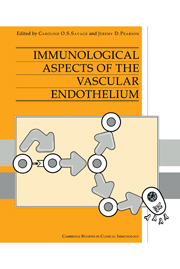Book contents
- Frontmatter
- Contents
- List of contributors
- Preface
- 1 New concepts of mechanisms in autoimmunity
- 2 Regulation of endothelial cell function by cytokines
- 3 Interactions between granulocytes and endothelium
- 4 The regulation of lymphocyte migration by vascular endothelium and its role in the immune response
- 5 Role of the vascular endothelium in immunologically mediated neurological diseases
- 6 The role of the endothelium in systemic lupus erythematosus and Sjögren's syndrome
- 7 The role of the endothelium in rheumatoid arthritis and scleroderma
- 8 The role of the endothelium in systemic vasculitis
- 9 Endothelial involvement in childhood Kawasaki disease
- 10 The role of the endothelium in thrombotic thrombocytopaenic purpura and haemolytic uraemic syndrome
- 11 The immunological role of the endothelium in organ transplantation
- Index
5 - Role of the vascular endothelium in immunologically mediated neurological diseases
Published online by Cambridge University Press: 04 August 2010
- Frontmatter
- Contents
- List of contributors
- Preface
- 1 New concepts of mechanisms in autoimmunity
- 2 Regulation of endothelial cell function by cytokines
- 3 Interactions between granulocytes and endothelium
- 4 The regulation of lymphocyte migration by vascular endothelium and its role in the immune response
- 5 Role of the vascular endothelium in immunologically mediated neurological diseases
- 6 The role of the endothelium in systemic lupus erythematosus and Sjögren's syndrome
- 7 The role of the endothelium in rheumatoid arthritis and scleroderma
- 8 The role of the endothelium in systemic vasculitis
- 9 Endothelial involvement in childhood Kawasaki disease
- 10 The role of the endothelium in thrombotic thrombocytopaenic purpura and haemolytic uraemic syndrome
- 11 The immunological role of the endothelium in organ transplantation
- Index
Summary
General introduction
The selective cellular barrier that separates the blood from the parenchyma of the nervous tissue has been increasingly implicated in the pathogenesis of diseases affecting central (CNS) and peripheral nervous systems (PNS). In recent years there has been particular interest in the potential role of these barriers in the development of diseases involving the immune system. The original doctrine of the nervous system being an immunologically privileged site has now been redefined to include the concept of a limited access of immune cells during their normal role of tissue surveillance. The role of the three vascular barrier sites, namely the blood–brain, blood–retinal and blood–nerve barriers (BBB, BRB and BNB, respectively) in the induction and propagation of disease processes can be divided into separate but related phenomena. First, the endothelial cells which form these barriers play a significant part in the recruitment of circulating immune cells. Secondly, they possess the potential to act as antigen presenting cells at the barriers and thirdly, leukocyte migration and the release of cytokines and other inflammatory agents leads to the disruption of the barrier, the formation of vasogenic oedema and secondary problems. Our current understanding of how these related phenomena are involved in various immunologically mediated diseases of the nervous system is outlined below. In this chapter we cover the most common of the immunologically mediated neurological diseases, and highlight the role of the vascular endothelial cell in this diverse range of clinical syndromes.
- Type
- Chapter
- Information
- Immunological Aspects of the Vascular Endothelium , pp. 96 - 123Publisher: Cambridge University PressPrint publication year: 1995
- 6
- Cited by



